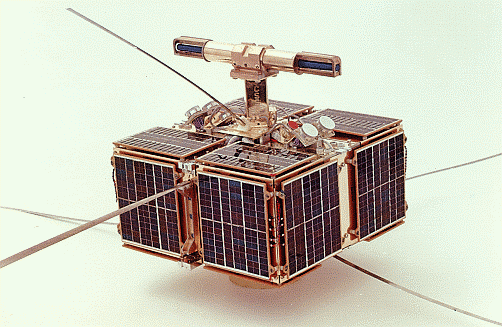MAGION 1
MAGION-1 was launched as a part of the Interkosmos-18 experiment and separated from this parent spacecraft on November 14, 1978, with the aim of studying the spatial structure of ELF-VLF phenomena using simultaneous measurements of the two near-spaced satellites. The MAGION-1 experiment went on for almost three years, till the decay date of September 10, 1981.
Both the satellite and subsatellite were launched into orbit by a single vehicle. The separation and activation of MAGION-1 were executed after Interkosmos 18 had been in orbit for three weeks when all the satellite systems had been tested and switched on as part of routine operations. A remote – control (telecommand) spring mechanism imparted an initial relative velocity of 0.2 m/s to MAGION-1 in the direction of the orbital velocity vector. This meant that the satellite and subsatellite drew away from each other at a rate of approximately 60 km per day.
Initial orbital elements: perigee 406km, apogee 764km, inclination 82.96deg., period 96.4min.
MAGION-1 subsatellite had the hape of a prizm with dimentions of 300x300x160mm, from which the individual sensors are aerials protruded. The surface finish of the satellite body was designed with regurd to passive temperature control. The weight of the subsatellite without the separation mechanism was 15kg.
MAGION-1 was equipped with the following main systems:
- 137MHz telemetry (0.25W) and 400MHz telemetry (1.5W),
- telecommand link (24 independent commands, 149MHz band),
- power system consisting of solar panels (2.4W), NI-Cd chemical batteries (2x38Wh) and a common DC-DC converter,
- magnetic field stabilization,
- a housekeeping system (for checking voltage, currents, temperature and for switching of the individual regimes).
Experiments:
- electric and magnetic fields from 0.05 to 16 kHz (broadband),
- narrowband channels (0.45, 0.8, 1.95, 4.65 and 15kHz),
- 16-channel frequency analyzer (0.185-15kHz, 60dB),
- resonance exciter (0.8 – 8kHz sweep),
- electric field 0.01 – 80 Hz,
- Geiger-Mueller tubes (electrons above 30 keV) in two directions, parallel and perpendicular to the magnetic orientation axis.

